Objectives
- Discuss leadership styles, traits, and practices as a nursing professional.
- Discuss the importance of effective interprofessional communication as a leader in nursing.
- Explore the role of servant leadership in nursing practice.
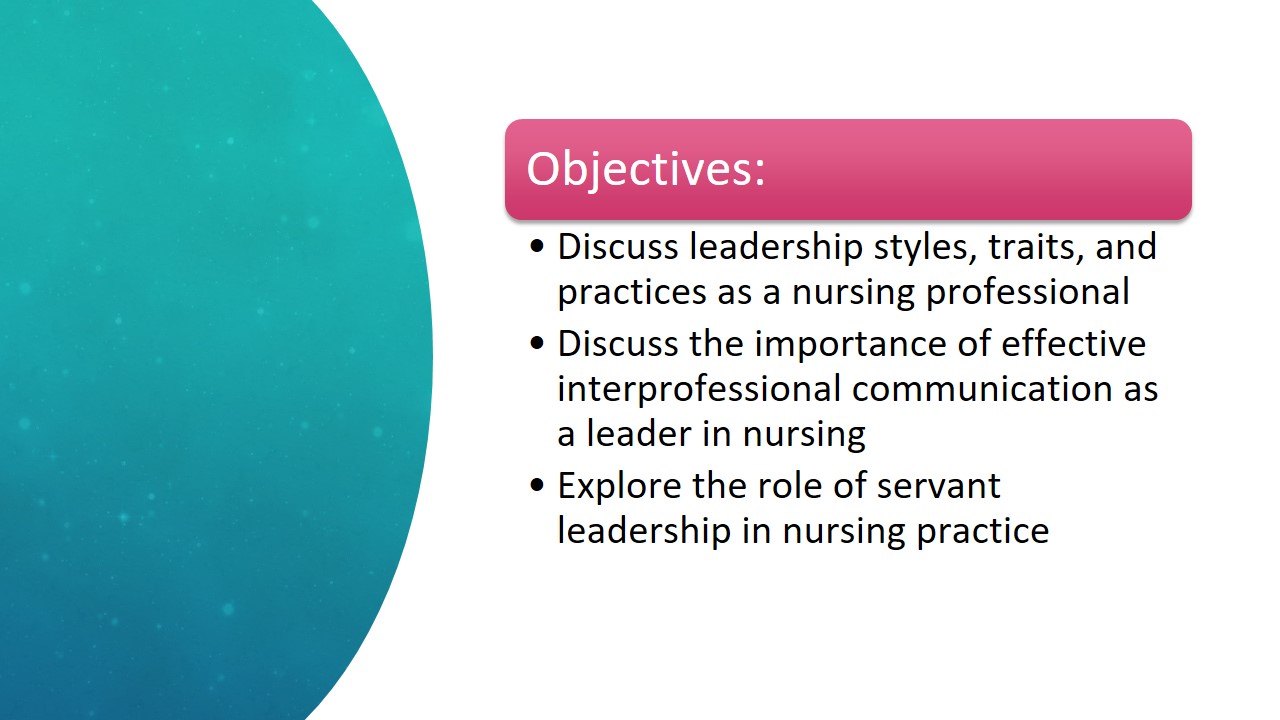
Babajide
- Leadership Style/Traits:
- My leadership style is transformational leadership. It involves influencing the followers towards the attainment of a particular goal (Lussier & Achua, 2016).
- Some of the traits that I posses are collaboration, creativity, emotional intelligence, dependability and integrity(Lussier & Achua, 2016).
- I practice transformational leadership by empowering followers by helping them overcome their weaknesses and encouraging them to articulate their ideas.
- Group Comparison:
- The leadership styles that are being utilized by my group members are servant leadership, charismatic leadership and transactional leadership.
- Charismatic and Servant leadership styles are effective at boosting followers’ productivity and motivation (Lin et al, 2015) while Transactional leadership increases productivity.
- The group members possessed the strengths of self-confidence, effective communication skills and dependability that enabled them win the loyalty and trust of their followers.
- The main weaknesses were lack of emotional intelligence and empathy such that they were unable to discern the needs of their members.
I use Transformational leadership style which focus on influencing follower’s attitudes towards the attainment of a particular goal. To be an effective transformational leader, I have to posses traits such as collaboration to facilitate teamwork, creativity to resolve problems, emotional intelligence to discern the needs of the followers, dependability and integrity. I exercise transformational leadership by helping followers resolve their weaknesses that hinder their productivity and urging them to voice their ideas including concerns.
Group members relied on servant, charismatic and transactional leadership styles. Servant leadership puts the interests of the followers first. Charismatic leadership involves persuading followers towards a particular vision and transactional leadership is based on giving incentives such as good pay for work done.
Strengths of the group members included self-confidence, effective communication skills and dependability. Through exercising these skills, they were able to lead their followers effectively. However, they lacked emotional intelligence leading to dominance that was interpreted as coercion by followers.
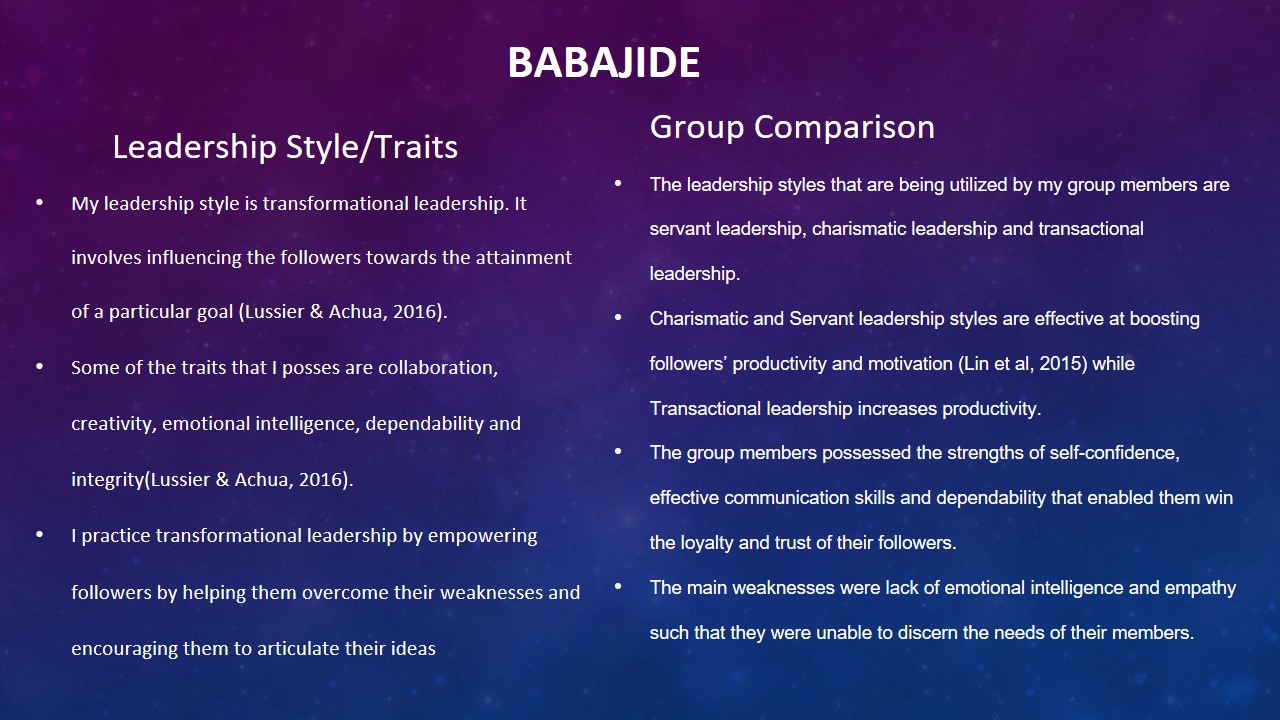
Wendy
- Leadership Style/Traits:
- Transformational-
- Excite team with shared vision;
- Excited team members will want to do their best to accomplish the shared vision;
- Want to see everyone succeed.
- Transformational-
- Group Comparison:
- Democratic-
- Asks for input from subordinates;
- Takes time;
- Survey;
- Vote;
- Implement.
- Democratic-
I believe that I am transformational, they have a positive vision for the future and engage those with the excitement in realizing the future that they would want to be a part of. My dad was a huge believer of PMA (positive mental attitude), with a positive mental attitude you can achieve great things. According to an article in Forbes (2016) they would characterize me as an idealist, unafraid to dream big dream, inspiring with the image of a positive future. Where they would caution one against such a style, is getting to “pie in the sky”, and not being able to reach such goals, could lead to discouragement and disengagement.
Democratic decision makers look to the team to bring forth the ideas. This is a great morale buster but it takes time and collaboration to implement which is fine for long term goals, but does nothing for a short term goal. It is important to understand multiple different leadership styles in order to be able to be most effective in your approach to reach the desired outcome.
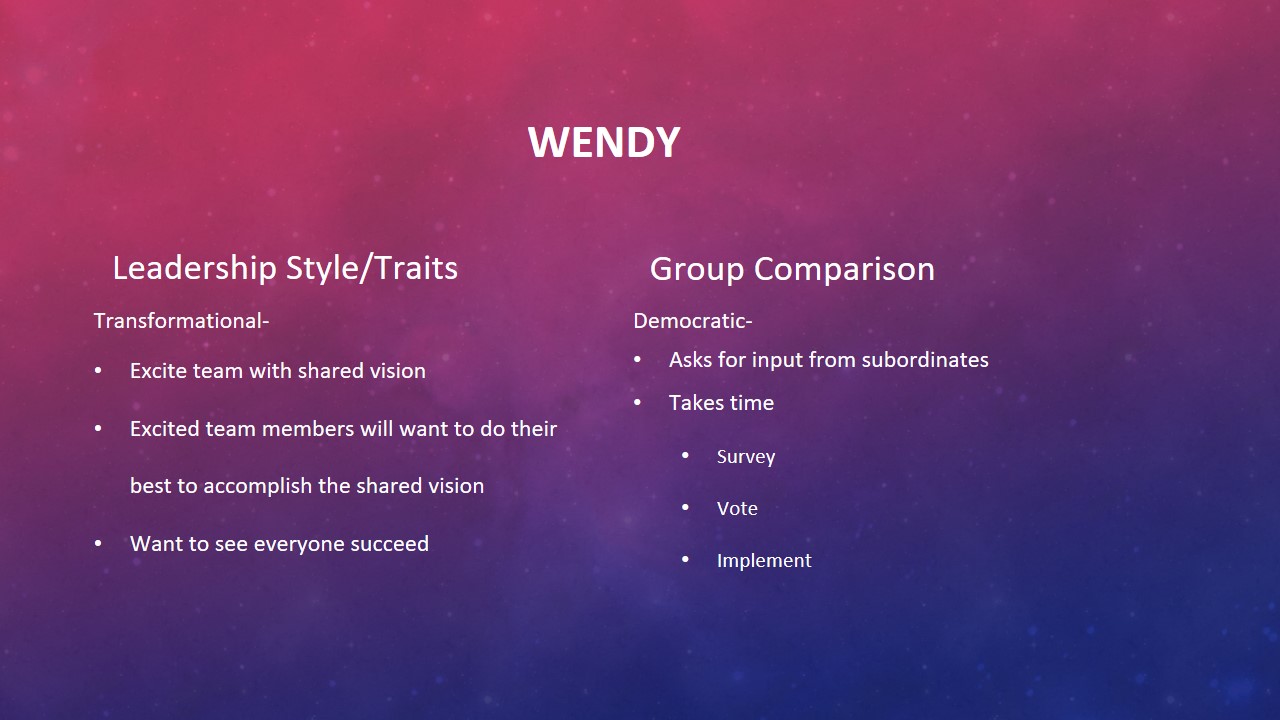
Dawnia
- Leadership Style/Traits:
- Transformational leadership style:
- inspire the patient by her example;
- collaborate with them to achieve the best possible outcomes;
- anticipate their needs.
- Transformational leadership style:
- Group Comparison:
- Transformational leadership is popular among other group member as well;
- Other members also possess democratic and servant styles;
- Group members also try to encourage their patients and collaborate with them, but nobody mentioned anticipation as an important leadership trait.
My leadership style is close to transformational. I have been working in dialysis for 12 years where patients usually feel very anxious about their future and require psychological support from nurses. I believe that successful treatment of my patients is possible only if the patient and nurse work and overcome all the difficulties together. Many dialysis nurses try to get into the situation of their patients by simulating some of the consequences of their illness. For instance, I spent some days in the wheelchair in order to be in the same position as the patient. I also tried to be proactive, because patients in the dialysis unit are often embarrassed to speak about their condition.

Amy
- Leadership Style/Traits:
- Democratic/Participative:
- Sets boundaries;
- Involves team members in all decisions;
- Helps to build trust;
- Struggles with response.
- Democratic/Participative:
- Group Comparison:
- Transformational- encouraging, inspiring, motivating.
- Different from democratic/participative as transformational leaders as they do not need the “upper hand” on the group.
My leadership style is democratic/participative. I am not sure how I feel about it as it seems that this type of leadership is so specific with their needs and wants. These leaders set parameters and goals for the group while also including them in the information. Taking the quiz and reading all the characteristics of this type of leadership helps me to understand why I always jump first to be a group leader. It is so hard for me to not do so, sometimes it is frustrating for me. I like perfection and it can sometimes get in the way of things and hurt feelings. I wish things were different sometimes.
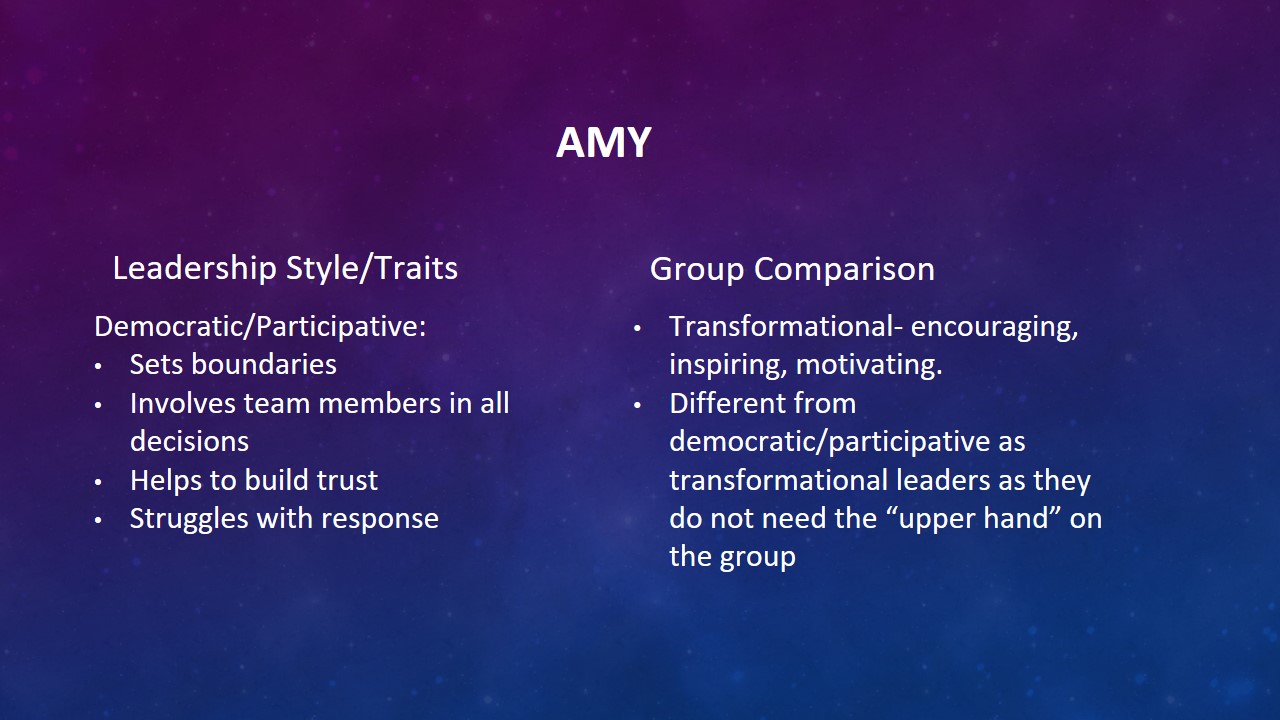
Syerenna
- Leadership Style/Traits:
- Servant:
- Provide nurses with education and tools needed to perform.
- Help when able.
- Democratic:
- 3 Types of change:
- Non-negotiable;
- Partially negotiable;
- Completely negotiable;
- Staff feedback.
- Accountability.
- 3 Types of change:
- Servant:
- Group Comparison:
- Other group members are more transformational:
- Inspiring;
- Charismatic;
- No group members have identified as Laissez Fair.
- Some group members have identified weaknesses or emotional maturity.
- Other group members are more transformational:
I would define my leadership skills and Servant and Democratic. I identify with servant leadership because I want to help nurses by providing them with the education, skills, and tools they need to provide the level of care that is expected of us to the best of their ability and demonstrate that I am available if they need help. I will gladly provide hands on education to improve nurses experience and confidence levels. It is important to mentor behaviors that will strengthen and empower nurses to affect change. I also identify with the democratic leadership skills because I enjoy engaging the staff in process improvement as much as possible. There are some changes that must happen and are non-negotiable, like indicating last dose given and next dose due on PRN medications for discharge. Some are partially negotiable such as hourly rounding; we must do this, but how do you want the process to look, what works for you. Then there are the decisions that are completely negotiable. Do we want to change from our current product to this new product? And ultimately holding one another accountable.
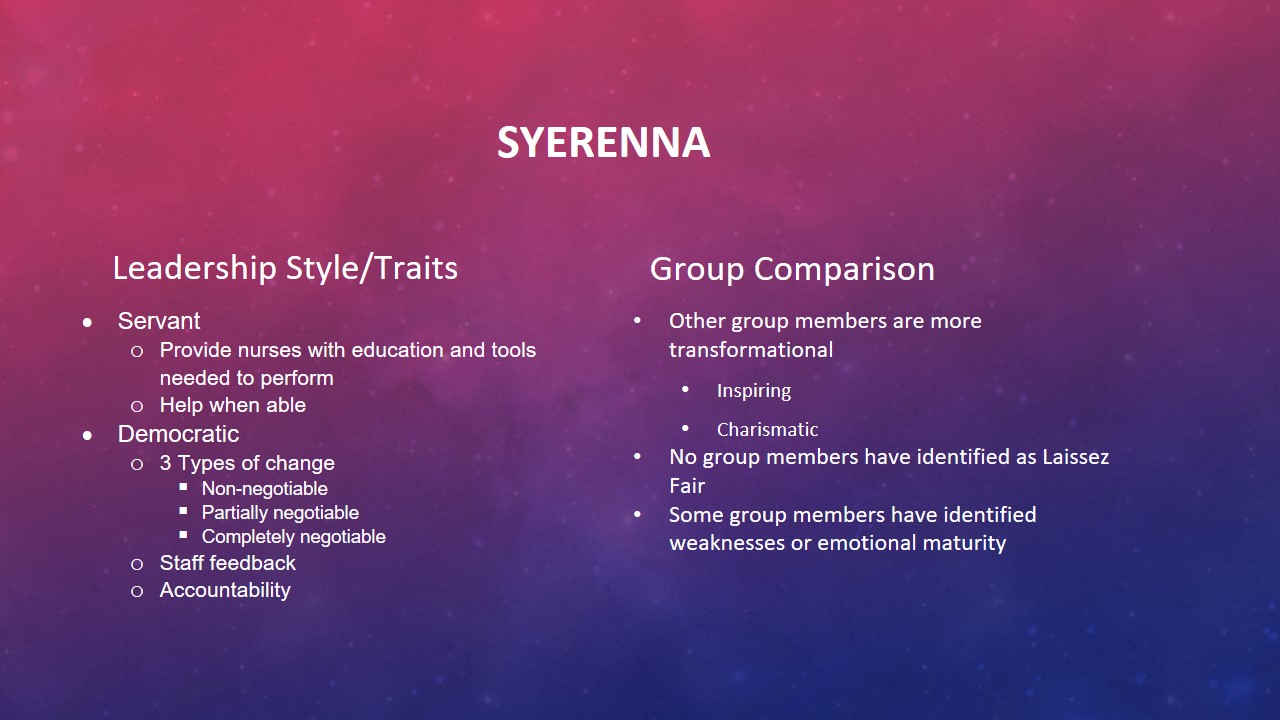
Leadership Cognizance
- Ensures well-being of patients;
- Helps the nurse to adapt to surroundings;
- Helps to achieve goals;
- Improves outcomes;
- Creates and maintains relationships.
In the modern world, a successful nursing leader should have qualities that would allow her to adapt to the ever-evolving environment. According to Al-Dossary (2017), a model clinical nurse, among other things, should be a “critical thinker, lifelong learner” and be “open to new ideas” (p. 256). This means that if some nurse is aware of her leadership traits, she is able to compare them to desirable features and decide on which aspect of her personality, she may need to work. Even if a nurse is aware of her personal leadership style and traits, still it would be of little use unless she is familiar with specific leadership tools that can be applied in real situations. Leadership style and traits might be somewhat vague terms since they exist only at the conceptual level. However, practices can be seen in real life in the shape of people’s actions. Nurses need to be aware of leadership tools they can use because this knowledge may help them to achieve their primary goal. Dahlkemper (2017) emphasizes such nursing leadership practices as cooperation with the patient, complete attention to the client, and “personalized care” (p. 21). It might seem that these practices are rather obvious and are realized by nurses intuitively. Nevertheless, these tools are the foundations of nursing leadership because they focus on caring about the patient. Nurses should pay attention to whether the leadership practices they use are, in fact, aimed at patients. Therefore, nurses can analyze the tools they use in order to eliminate all those that do not pursue the goal of achieving the best possible patient outcomes.

Necessary Leadership Traits & Styles for Effective Communication
Leadership traits and styles are necessary to be an effective communicator include vision, integrity, motivation, optimism, collaboration, accountability and empathy.
Having a true picture of what to be achieved and understanding the feelings of other team members go a long way in leadership because leadership role enables leaders to put themselves in some members’ shoes. Empathy enhances the heart of all transaction called communication, and effective communication determines task outcomes. Leaders who are confident in their responsibilities and accountabilities will not struggle in performing their tasks; because they possess positive mind-set and inspiration. They also embrace self-relaxation otherwise called “emotional stability” in spite of or in the face of stress and frustration.
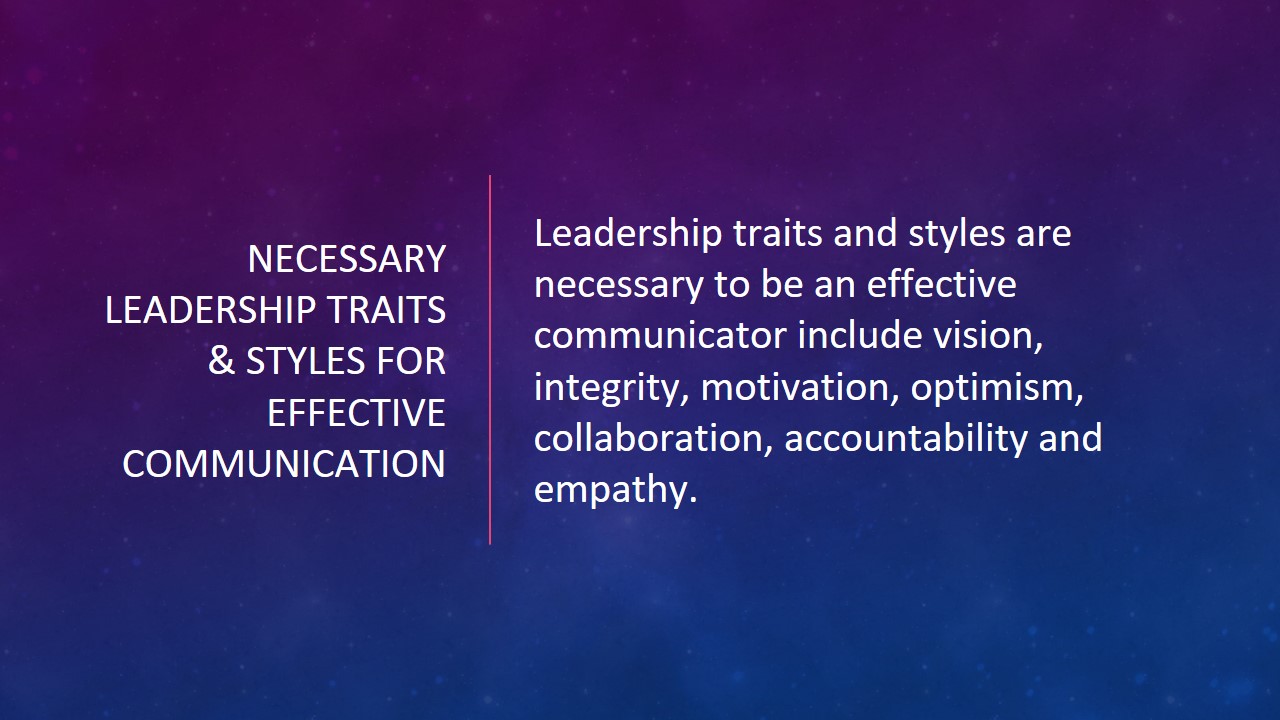
Communication and Collaboration
- Effective communicators possess emotional intelligence and good oratory skills. Emotional intelligence helps the speaker discern the needs of the audience. Good oratory skills help the speaker pass their message to the audience in a persuasive manner (Lussier & Achua, 2016 ).
- The leadership styles that foster effective communication are Transformational and Charismatic Leadership styles because they focus on motivating followers through oratory skills (Lussier & Achua, 2016).
- Leaders adapt different communication approaches to: Ensure that the message is communicated in a way that is appropriate for the specific audience ; Ensure that the leader achieves his/her goal of communicating which can vary from inspiring to offering information (Sparks, et al., 2014).
Essential traits to be an effective communicator are good oratory skills-to express oneself properly and emotional intelligence- to determine the needs of the audience. Transformational and charismatic leaderships styles are crucial to developing effective communication because they rely on using language to influence and motivate followers. Leaders have to alter communication approaches to pass their message effectively and to achieve their goal of communicating.
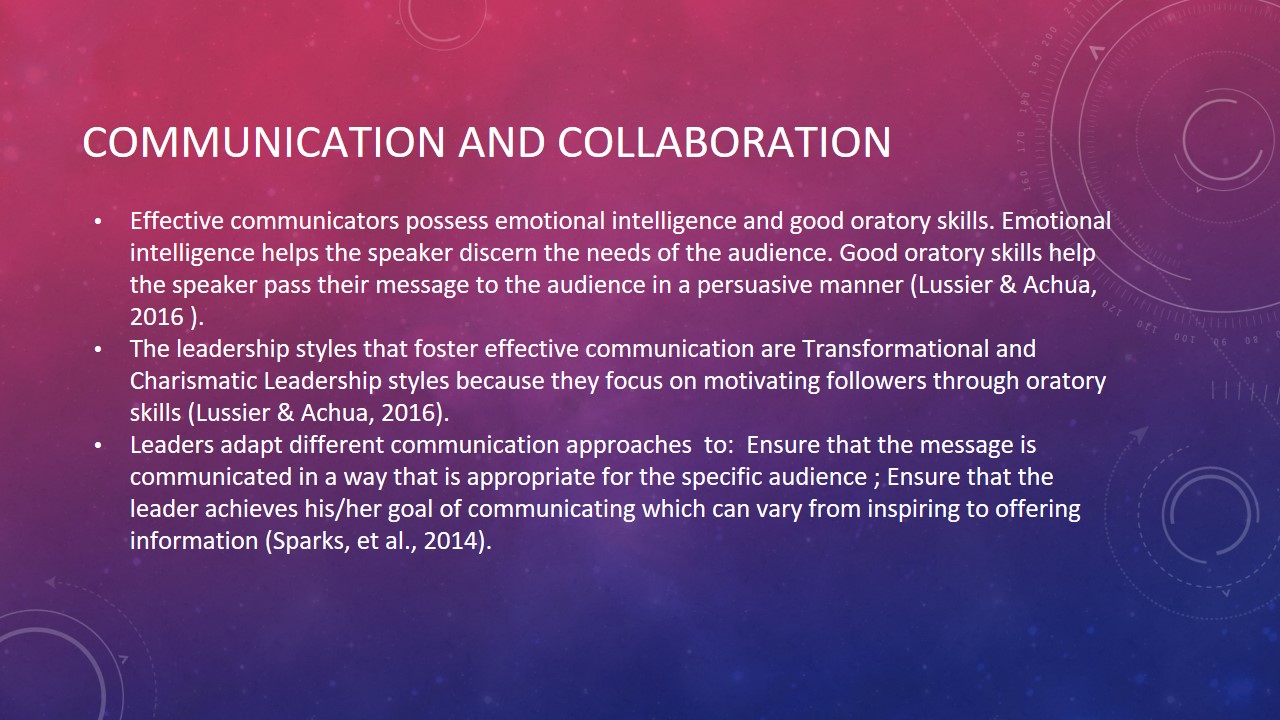
Servant Leadership
- Listen;
- Actively, not passively;
- Empathy;
- Being fully present;
- Healing;
- Not problem solving;
- Awareness;
- General and self-awareness;
- Persuasion;
- Belief in a shared vision;
- Conceptualize;
- Keep daily & long term goals in balance;
- Foresight;
- Proactive not reactive;
- Stewardship;
- Doing what is right for the whole;
- Commitment to Growth of Others;
- Not just as employees but as Human Beings;
- Building Community;
- Celebrate volunteerism, build staff as community regardless of hierarchy (Gandolfi & Stone, 2018).
Servant Leadership was first defined by Robert Greenleaf in 1970, this type of leadership is rooted in the golden rule, and is simply stated as servant first. It is easy to see where this could be seen as a religious connotation as we are all servants of God. However we must look as these tenets as serving our neighbor, fellow human beings. The American Nurses Association (Nd) states “when there is someone in need of care, nurses work tirelessly to identify and protect their needs”, so it seems only natural that nurses would respond positively to a leadership that holds the same values. Nursing is a unique profession and one that is growing daily, having positive role models is imperative to the continued innovation and growth. Servant leadership is active, provides a shared vision that empowers and inspires by serving the needs of those in their charge ahead of their own needs.

Successfully Leading Others
- Strong Understanding.
- Balancing Act.
- Putting others first.
- Trust building, investing, participating.
Servant leaders who have a strong understanding of their personal leadership traits can be more successful leading others and navigating the challenges of health care by providing support and assistance to their staff and coworkers in practice, information sharing, and collaboration. Decisions, changes, and interactions are balanced with moral and ethical consideration and part of that consideration is that the staff have the necessary tools and education to meet the expectations of the organization and the clients. A servant leader will put the needs of the staff ahead of their own (Norris 2017). For example, if the nurse manager has been instructed to improve call light response time. First the nurse manager would need to be on the floor answering lights and assessing what the actual practice of staff is, then create discussion and open dialogue to explore ways it will be possible to meet the goal, then begin with the easiest to institute that has the highest probability of success. It is more important that the staff understand the goal, can participate in the solution, and have the needed tools to achieve success rather than the ability of the nurse manager to return in x amount of days and report improvement. Leading by example is also a very important trait of the servant leader (Carter 2014). Leading by example serves multiple purposes including trust building, investment and participation in the goals and relationships with coworkers, and modeling expected behaviors and attitudes while providing professional support. If you are cutting dangerous corners in your practice as the example you provide to your staff or you are backhanded and not truthful with compassion in difficult situations your credibility and cooperation from staff will be very poor and the organization and the staff in it will suffer.
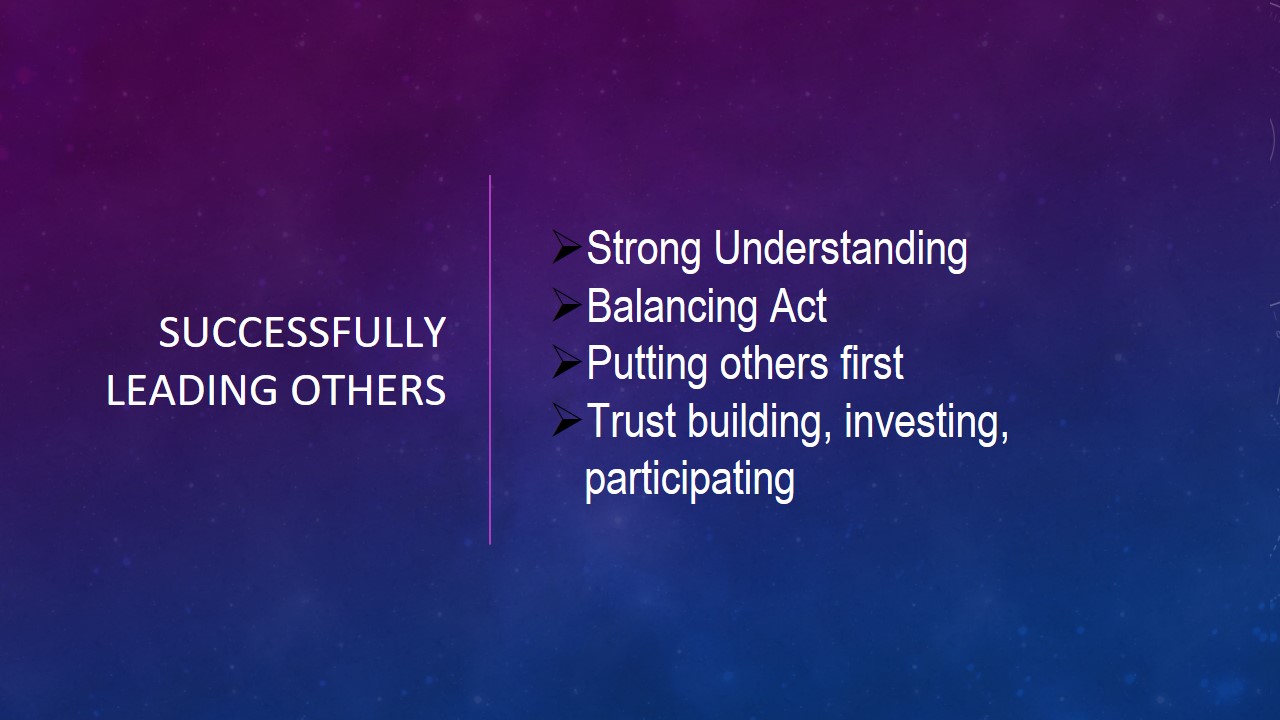
References
- Al-Dossary, R.N. (2017). Leadership in nursing. In A. Alvinius (Ed.), Contemporary leadership challenges (pp. 251-264). London, UK: IntechOpen.
- American Nurses Association (Nd) What is nursing. Web.
- Carter, D. danonrcarter@gmail. co., & Baghurst, T. tbaghurst@live. co. (2014). The Influence of Servant Leadership on Restaurant Employee Engagement. Journal of Business Ethics, 124(3), 453–464. Web.
- Dahlkemper, T. (2017). Nursing leadership, management and professional practice. Philadelphia, PA: F.A. Davis.
- Gandolfi, F., & Stone, S. (2018). Leadership, Leadership Styles, and Servant Leadership. Journal of Management Research (09725814), 18(4), 261–269. Web.
- Lin, P., Maclennan, S., Hunt, N., & Cox, T. (2015). The influences of nursing transformational leadership style on the quality o nurses working lives in Taiwan: A cross-sectional qualitative study. BMC Nursing, 15(33).
- Lussier, R. & Achua, C. (2016). Leadership: Theory, Application & Skill Development. Boston: Cengage Learning.
- Norris, S., Sitton, S., & Baker, M. (2017). Mentorship through the lens of servant leadership: the importance of accountability and empowerment. NACTA Journal, (1), 21. Web.
- Sparks, J., Song, Y., Brantley, W., & Liu, O. (2014). Assessing written communication in higher education: Review and recommendations for next generation. ETS Research Report. Web.